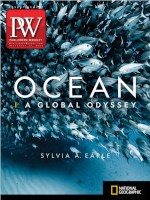Canada is the world’s second-largest country, and yet with only about four people per square kilometer, it has one of the lowest population densities. The country slices the North American continent at the 49th parallel, ridging the waterways cut by the Great Lakes along which Indigenous Peoples, later joined by European fur traders, portaged for generations. Stretching from sea (Atlantic) to sea (Pacific) to sea (Arctic), the country’s northernmost tip, Ellesmere Island, in the Qikiqtaaluk Region of Nunavut, touches the 83rd parallel, and is covered in nearly 900 meters of ice. About 191 people live there today. Most of Canada’s population of about 37 million, however, clusters in cities towards the south, by the United States of America border.
While hundreds of years of European colonialism, imperialist extraction, and industrialization have deeply scored and disrupted our wilderness, so many of the stories that define Canadian literature speak of our relationship with both the generative and perilous powers of the spacious nature we inhabit and share with wildlife, as well as the inclement weather we survive.
To touch on just a few examples: Suzanna Moodie’s Roughing It in the Bush (1852) is a first-person account of homesteading in Upper Canada. Germaine Guèvremont’s novel, Le Survenant (1945) , wrestles with notions of parochial duty in juxtaposition with the promise of freedom and adventure in the wild.
Tomson Highway’s play Ernestine Shuswap Gets Her Trout (Talonbooks, 2005), set in 1910, describes how the Native Peoples of British Columbia lost their fishing and hunting lands and language rights. Miriam Toews’s A Complicated Kindness (Alfred A. Knopf, 2004) describes contemporary Mennonite rebels adrift in the Canadian prairies. Christian Guay-Poliquin, in both his novels, Le poids de la neige (La peuplade, 2016) and Le fil des kilomètres (La peuplade, 2013), explores survival, winter, and traversing the vast distances of the continent.
Renowned scientist David Suzuki and author Wayne Grady together tell the story of a 500-year-old Douglas fir in Tree: A Life Story (Greystone Books, 2004). Environmental historian Jessica L. Lee’s memoir Two Trees Make a Forest (Hamish Hamilton, 2019) is a meditation on travel, nature, and family. Rachel and Sean Qitsualik-Tinsley imagine the meeting of Tunit and Viking cultures in their coming-of-age story Skraelings (Inhabit Media, 2014).
From the First Peoples’ thousands-years-old oral stories and powerful creation myths and the early European explorers’ vivid reconnaissance and survival accounts, to today’s myriad of modern literary expressions that reference these and other traditions of naming and understanding our territory, Canadian narratives continue to explore our physical surroundings, our climate, our relative isolation, and how we engage with one another in these ever-evolving intersecting ecosystems of culture, language, nature, inheritance, history, and identity.



 Volume 268
Issue 39
09/27/2021
Volume 268
Issue 39
09/27/2021





